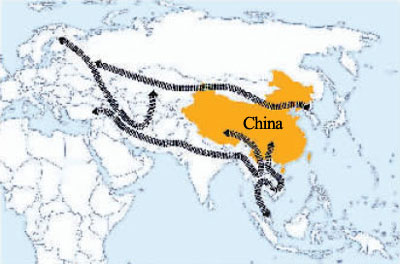
| Trans-Asia
Rail Link -
A long link between China, various countries in Asia and Russia  Picture: Sketches of Trans-Asia Railway
(TAR) network
Source: from People Daily Newspaper, China On November 10, 2006, the UN announced the signing of a transportation agreement by 18 transport ministers in connection with the Trans-Asia Railway Network (TAR) in Pusan, South Korea, which started off the UN project to connect the Far East to Western Europe by a rail link. TAR is often compared to the ancient Silk Road, the old trade route from China to Europe that connected the farthest corners of the known world for centuries. The initial plan started in 1960 envisioned a continuous 14,000-kilometer rail link between Singapore and Turkey, via Southeast Asia, India, Pakistan, and Iran. But with rapid economic growth and increasing interdependence, the TAR has grown exponentially. Today, it encompasses a complex network of nearly 81,000 kilometers spread over four major geographical regions.   Source: www.unescap.org
Benefits of Trans-Asia Railway (TAR) - Improving Access To Landlocked Countries The landlock country's access to world markets is heavily dependent on efficient rail links to international ports. Twelve of the world's 30 landlocked countries are in Asia, and 10 of those are TAR members. UNESCAP experts believe that port efficiency can be enhanced through the integration of rail and shipping to avoid port congestion. That is a key factor in Asia, which is home to 13 of the world's 20 largest container ports. Some of the Hurdles: Even though significant obstacles remain to complete the TAR Project, including technical impediments and funding for nearly 6,500 kilometers of railroad, some progress has been achieved as Business-in-asia.com has followed up on the project. One of the technical hurdles confronting TAR is the different rail widths, or gauges. Rail systems in the former Soviet Union, for instance, use a wider gauge than those in China. The system in India, on the other hand, differs from them both. Kim says the problem will be overcome with the help of containers, which are already widely in use worldwide. More of our useful articles:
|
